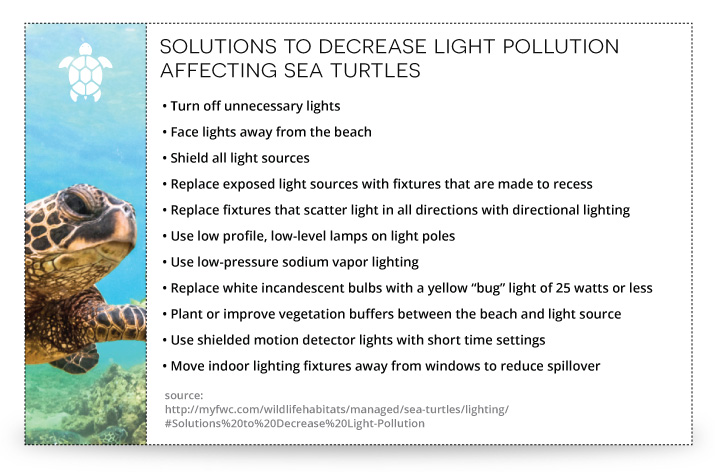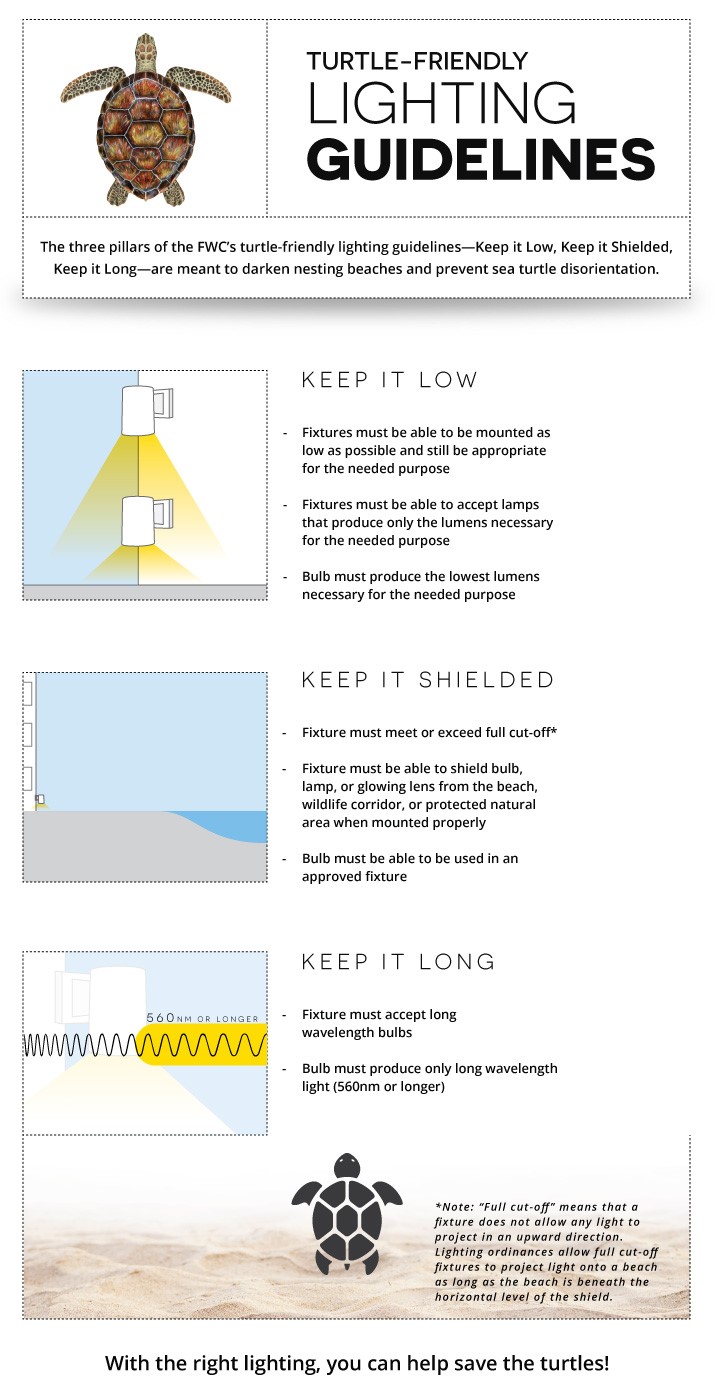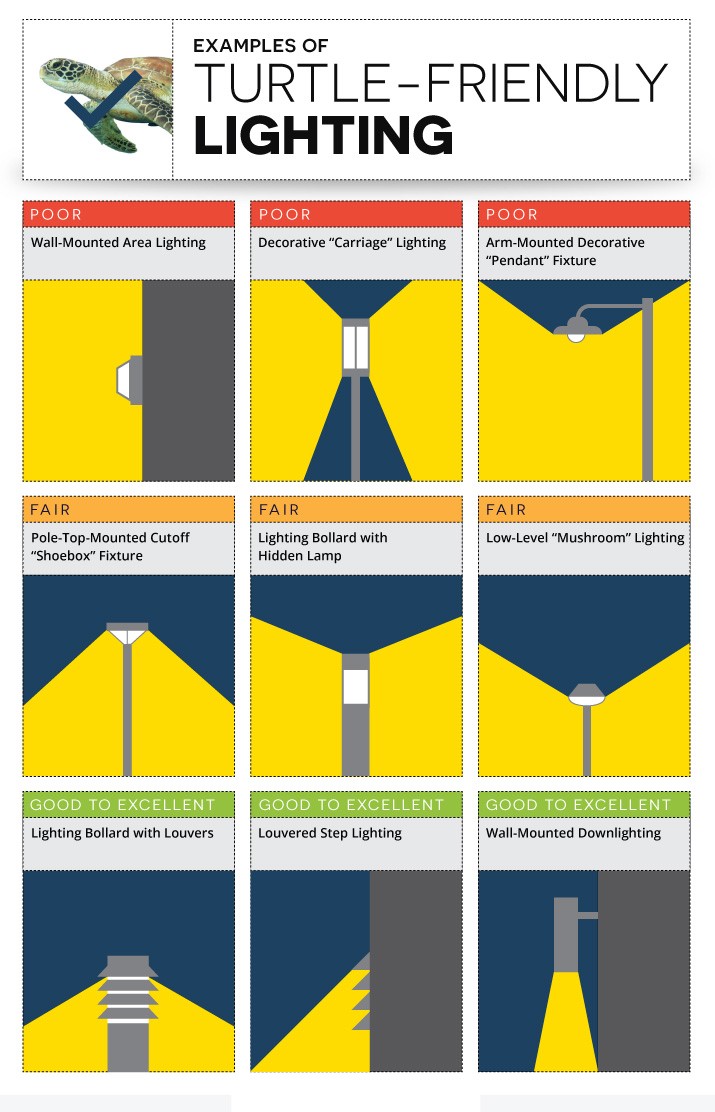How Artificial Lighting Affects Sea Turtles

By some estimates, only 1 in 1,000 sea turtle hatchlings will survive to adulthood. Natural selection accounts for most of these losses (and explains why female sea turtles lay so many eggs) but there’s also a more recent threat that humans are directly responsible for: artificial lighting.
When all the turtles on a nesting beach are ready to hatch out, they do so virtually in unison and typically under the cover of darkness to protect themselves against predators and the sun. Once hatched, the tiny sea turtles find their way to the ocean via reflections of the moon and stars on the water. Unfortunately, artificial lighting from nearshore buildings and streets can cause hatchlings to become disoriented and wander inland. The further away from the ocean the baby turtles wander, and the longer they are exposed, the lower their odds of survival.
Lights from waterfront condominiums, hotels, and businesses can also affect nesting site locations. Artificial lights can discourage female sea turtles from nesting, causing them to resort to less-than-optimal nesting spots on dangerous beaches or deposit their eggs in the ocean. In either case, the survival outlook for hatchlings (which is already slim) becomes even bleaker.
Turtle Safe Lighting: Best Practices and Best Fixtures

Unfriendly beach lighting is certainly a threat to sea turtles, but it’s also quite easy to fix. Turtle safe lighting practices and specialty fixtures can help reduce the number of hatchlings unnecessarily lost before they ever reach the water. In either case, the aim is to reduce the amount of artificial light that is visible from nesting beaches.
Lighting Practices Beachfront
Nearly 90 percent of sea turtle nesting in the United States occurs in Florida, so many of the “best practices” and turtle-safe lighting guidelines come from organizations like the Florida Fish and Wildlife Conservation Commission (FWC). For beachfront property owners, the FWC offers the following suggestions on how to decrease light pollution affecting sea turtles:
The FWC has also established lighting criteria intended to minimize the impact on sea turtle populations. The three pillars of FWC’s turtle-friendly lighting guidelines—Keep it Low, Keep it Shielded, Keep it Long—are meant to darken nesting beaches and prevent sea turtle disorientation. The FWC has also established a certification process for lighting manufacturers who wish to market and sell turtle-safe lighting products.
Sea Turtle Nesting Season Tips
During sea turtle nesting season (May 1-Oct. 31), please heed the following turtle-friendly tips. Starting early is great too; sometimes the first local sea turtle nests arrive in April.
DO stay away from sea turtle nests marked with yellow stakes and tape, and seabird nesting zones bounded by ropes.
DO remain quiet and observe from a distance if you encounter a nesting sea turtle or hatchlings.
DO shield or turn off outdoor lights that are visible on the beach from May through October.
DO close drapes after dark and stack beach furniture at the dune line or, ideally, remove it from the beach.
DO fill in holes that may entrap hatchlings on their way to the water.
DON’T approach nesting turtles or hatchlings, make noise or shine lights at turtles.
DON’T use flashlights, head lamps or fishing lamps on the beach.
DON’T encourage a turtle to move while nesting or pick up hatchlings that have emerged and are heading for the water.
DON’T use fireworks on the beach.
Why Long-Wavelength Light?
Shorter wavelengths of light (like those emitted by everyday light bulbs) appear similar to the light reflected off the ocean, causing hatchlings to become disoriented. Longer wavelengths of light are less disruptive to sea turtles and appear dark yellow or red to the human eye, which can have the added benefit of creating warm and intimate lighting when used appropriately.
Certified Turtle-Safe Lighting from Reita
In an effort to make beachfront lighting safer for turtles and more attractive for businesses and residents, Reita Lighting offers turtle-friendly lighting fixtures and LED lamps that have been approved by the Fish and Wildlife Conservation Commission. Reita’s bi-pin series turtle-safe LED lamps have been designed to counteract the effects of light pollution near beaches while matching the form factor and illumination of the incandescent bulbs they replace.
Reita’s Wildlife Lighting Certified landscape area light fixtures have also been designed to provide adequate and beautiful lighting for humans while being virtually invisible to sea turtles. The entire turtle-safe outdoor lighting series can help minimize your impact on sea turtles while adding a warm and intimate feel to your home or business.
